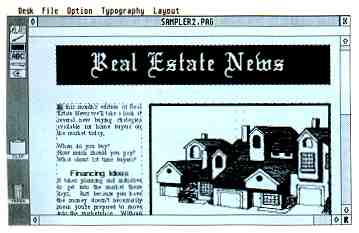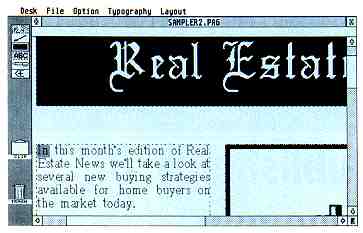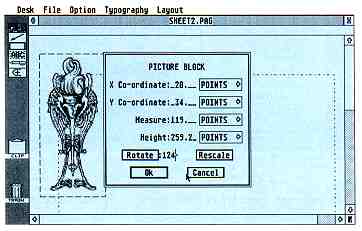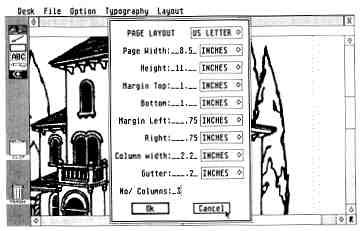Fleet Street Publisher 3.0
The UK's Newest Foray in the DTP War
BY DAN FRUCHEY

Fleet Street's actual-size editing
screen.
The screen fonts are indicative of
size and
position only and are not as sharp
as they
are when printed.
Two years ago, Fleet Street Publisher, a desktop publishing program imported from England, had its moment in the sun and then quietly disappeared. Although the product was well made, it was generally ignored by U.S. consumers and, for the most part, it passed from memory.
There were many reasons for the program's passing: an underdeveloped publishing market, a lack of printer drivers and a higher-than-average price contributed to the program's downfall. Today, with a more mature market and more realistic expectations from users, the product could do quite well.
MichTron and Mirrorsoft Ltd. Have reintroduced Fleet Street Publisher to the United States market. Significant revisions to the software, additional printer drivers and the support of one of the largest publishers of ST software all contribute to make Fleet Street Publisher 3.0 a product worth examining.
General Overview
Fleet Street Publisher 3.0 is designed to meet the needs of all ST
users. The program runs on any ST or Mega computer, regardless of memory
configuration or hardware combination. (The manual recommends a monochrome
monitor, as the rectangular pixels used in medium resolution on a color
monitor don't portray a proper screen image, and if you use low resolution,
plan on a lot of scrolling during page layout).
intelligently creates
additional font sizes
in increments as small
as 1/100 of a point.
The package contains three double-sided disks (or six single-sided disks on request) and a well-indexed 265-page manual that includes tutorials, glossaries, a catalog of clip art included on the disks and an overview of desktop publishing uses and concepts. The program can be run immediately with most system configurations. However, laser printer owners must make some simple changes in fonts and drivers prior to use.

Like Calamus and Timeworks Desktop
Publisher,
Fleet Street lets you zoom in or out
to various levels.
This screen is double-sized.
Fleet Street uses the standard GEM drop-down menus and windows. Along the left side of the screen there are also seven icons for switching modes, a clipboard and a trash can. The layout of the screen and menus is identical to earlier versions, but many new options accessed from the drop down menus give Fleet Street much more power.
General Layout
Pages can be generated automatically using predefined formats and unusual
page sizes can be defined manually. If large pages prove inconvenient,
you can piece together posters or banners using multipage documents; the
only limitations seem to be printer capabilities and the amount of RAM
available.
Margins, gutters and column guides are all set when a page is created. You can arrange these layout elements with up to 1/100 unit accuracy using a variety of common measuring systems including points, picas, millimeters, centimeters or inches.
You can use rulers or guides with separately adjustable horizontal and vertical functions for manual layout. For exact sizing and placement you can also view and enter x,y coordinates when creating columns or text and graphic blocks.
Text and Font Manipulation
You can create and edit text on screen or import it with word processing
commands intact from WordPerfect, 1ST Word or Word Writer ST. If you're
using ST Writer or another word processor that is not supported, Fleet
Street has a desk accessory that strips the file's control codes prior
to importation. (Editor's note: If your file is in ST Writer format,
we suggest you use SIFT, START's instant File Translator, from the June
1989 issue.)

Fleet Street's Picture Block function
lets you rotate
image graphics in one-degree increments
and size
an image to exact dimensions. Fleet
Street 3.0 will let
you rotate vector graphics also.
You can route text between columns or between pages. If text loaded into a column exceeds the room available, an icon will indicate that the text should be routed to another location. Standard options such as search, search and replace, cut and paste, copy and delete are all available. You can define up to 20 text macros for commonly used style and format options.
Another handy feature provides constant updates for statistics such as word count, font size and justification modes. These constant reminders are a great help when editing documents.
Fleet Street Publisher
3.0 is a powerful
publishing program.
Word, letter and line spacing are all freely adjustable and a user-defined table allows discretionary hyphenation of words. Another table allows insertion of justification parameters such as justify full, right- or left-justify or center text in a column.
Fleet Street uses GDOS fonts in a unique way that allows a greater variety of size and style options. Actual fonts serve as templates for intermediate point sizes. Most programs that use GDOS fonts can only access the actual sizes available and a doubled duplicate of each size. Thus, typically, a program that uses 10, 12 and 14 point fonts can also double these sizes to get a series of rougher 20, 24 and 28 point sizes.
But Fleet Street intelligently creates additional sizes in increments as small as 1/100 of a point. Although you may only have a font in 10, 12 and 14 point sizes, the program can translate this data into any font size up to 255 points. This size emulation isn't perfect, however. A 10-point font emulating a 60-point font will appear rougher than the same font generated from an 18-point font.
At the same time, Fleet Street offers a greater variety of text style options than other programs that use GDOS fonts. Text can be skewed, outlined, thickened and underlined, as in other GDOS programs, but it can also be flipped, mirrored, inverted and overlined. The underline and overline can be adjusted to any distance from the text and the thickness of the line can be adjusted - a must for larger font sizes. Text can be shaded in any intensity from one percent to 100 percent, small caps (uppercase letters in both upper and lowercase letter sizes) can be automatically generated and more.
Fleet Street will use any GDOS font, but the package includes six font families in many sizes. Also, a utility included with the package can compress fonts so that they will consume less RAM and disk space.
options is the ability
to configure and save
default settings for
most program options.
Graphic Functions
Fleet Street imports pictures in image (.IMG) and metafile (.GEM) formats.
A separate included utility will also convert NEOchrome, DEGAS and Art
Director pictures to image format.
Once a bit image picture is loaded into Fleet Street, it can be cropped, rotated in one-degree increments, edited or scaled to any printer. Pictures can be sized automatically or duplicated according to any measurement scheme you desire (points, picas, millimeters, centimeters, inches).

The Fleet Street Page Layout function.
It's all right
in front of you: you can set up the
size of the
columns, the space between them (gutter)
and the
margins.
Currently metafiles (graphics imported from Easy Draw, CAD-3D, Athena II, etc.) can only be copied and sized, not edited. This is standard when importing vector graphics.
Lines and boxes can be defined using virtually any line thickness. You can fill them with any of the standard GEM patterns and keyboard input of specific x,y coordinates allows precise sizing.
Printing and "Other" Options
Unlike common GDOS programs, Fleet Street can zoom or magnify pages
in sizes from 12.5 percent to 200 percent of the original. Extensive help
menus and status reminders are available.
One of my favorite options is the ability to configure and save default settings for most program options. Once you've used the program enough to decide what you like, you can save a custom setup.
A collection of 148 graphics is included with Fleet Street covering a wide range of images. With the inclusion of graphics, everything you need to publish is at hand.
Fonts and printer drivers for most 9-pin and 24-pin dot matrix printers are included. There are also fonts and drivers for the Atari SLM804, Hewlett-Packard and Postscript laser printers.
Fleet Street prints lightning fast on the Atari laser printer. A typical time for printing a page ranged from 30 seconds to one minute. Obviously dot matrix printers take longer but the time needed to produce a page was not excessive.
Since some printers have much slower printing speeds, there is a draft printing mode to speed up preliminary copies. You can also print files to disk as images and then load them into other programs or even reload the pages in Fleet Street as pictures.
Personal Impressions
Initially I was a little overwhelmed by Fleet Street. The many options
and sub-options with their configurable design can be confusing. Because
of the sheer number of options available I found myself referring to the
manual frequently and, until I set up my own system defaults, use was sometimes
cumbersome.
Make no mistake - Fleet Street Publisher 3.0 is a powerful publishing program. I would especially recommend it to computer users who currently own GDOS products or have access to GDOS fonts.
There are only two shortcomings I'd like to see addressed. First, the program doesn't use grids. This is an invaluable layout aid and, although I can live without grids, they speed up page design. Second, I consider a wide range of keyboard macros a must and, although Fleet Street does use keyboard macros for text commands, it lacks macros for most commands from the drop-down menus.
Still, the program works well and I never encountered a lock-up or system failure of any type (thunderous applause). Fleet Street is a worthwhile addition to MichTron's line of Atari products and to the desktop publishing market.
Ultrascript and Fleet Street
To increase the potential of Fleet Street, MichTron has signed an agreement
with Imagen to bundle Fleet Street with Ultra-script, the Postscript emulator.
The package includes the Lucida family of fonts. Fifty other fonts can
also be purchased directly from Imagen.
Ultrascript increases the clarity of text output. It lets you output Postscript-compatible files of high quality to an HP Deskjet, Atari laser or dot matrix printer (9- and 24-pin).
GDOS fonts in a unique
way that allows a
greater variety of size
and style options.
The sample pages I have seen look outstanding and I have high expectations for both products as a team. Before you get too excited, however, there is a catch: you must have at least two megabytes of memory available to use Ultrascript and Fleet Street together. Whether or not the products can be used separately with less RAM consumption remains to be seen; tests with both products were not quite completed at the time of this writing.
If you already own Ultrascript or you don't have two meg of memory, don't despair MichTron will let you purchase Fleet Street separately. It will be released some time in August. Pricing for Fleet Street, 3.0 upgrades, and Fleet Street with Ultrascript were not announced prior to deadline for this article. Keep your eyes open for pricing information here when it becomes available.
Dan Fruchey, formerly the desktop publishing columnist for ST Applications, works as a paramedic in Santa Rosa, California and runs a small clip-art business on the side.
PRODUCTS MENTIONED
Fleet Street 3.0, no price set. MichTron, Inc., 576 S. Telegraph,
Pontiac, MI 48053, (313) 334-5700.
CIRCLE 161 ON READER SERVICE CARD